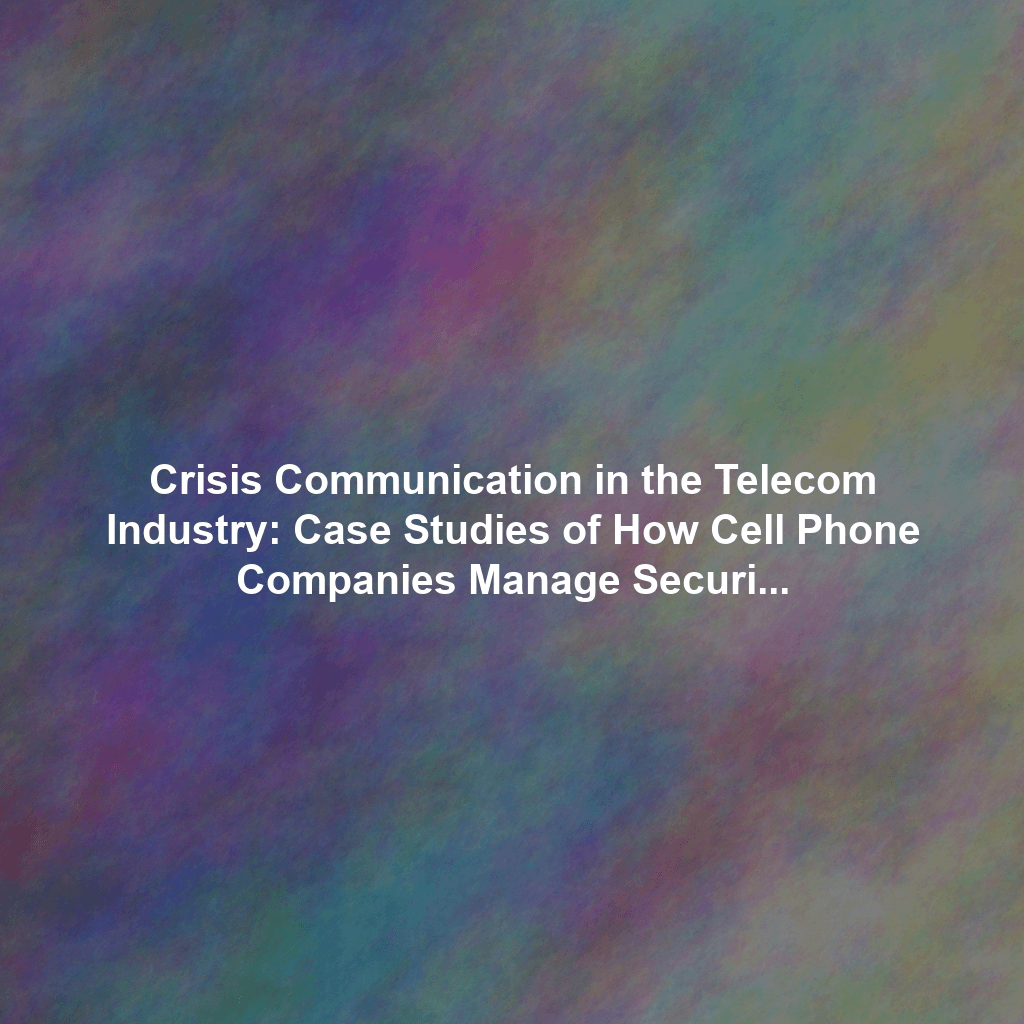The High Stakes of Telecom Crisis Management
The telecom industry faces unique challenges in crisis communication. Not only do they handle sensitive personal data for millions of customers, but they also provide a critical service – connectivity. When that connectivity is disrupted, or that data is compromised, the impact is immediate and widespread.
Data Breaches: A Constant Threat
Data breaches are perhaps the most feared and frequent crisis in the telecom sector. The sheer volume of personal information stored by these companies makes them prime targets for hackers. When a breach occurs, the company must act swiftly to contain the damage, notify affected customers, and restore trust. Consider the Equifax breach in 2017. While not a telecom company, the impact rippled across industries, highlighting the critical need for robust security measures and transparent communication.
Network Outages: Losing Connection, Losing Trust
A widespread network outage can cripple communication and cause significant disruption to businesses and individuals. The immediate response needs to be focused on restoring service and providing clear, accurate updates to customers. The longer the outage persists, the more damage it inflicts on the company’s reputation. Think back to the Rogers outage in Canada in 2022. Though not US based, the effects were significant, impacting emergency services, banking, and daily life for millions.
Controversial Business Decisions: Navigating Public Opinion
Sometimes, the crisis isn’t caused by an external event, but by an internal decision. Changes to pricing plans, data policies, or even mergers and acquisitions can spark public outrage and necessitate careful communication. Managing public opinion requires transparency, empathy, and a willingness to address concerns head-on.
Case Studies: Learning from Successes and Failures
Let’s examine specific examples of how major cell phone companies have navigated past crises:
T-Mobile: Addressing Data Breaches Head-On
T-Mobile has, unfortunately, been a frequent target of cyberattacks. Their response strategies have evolved over time. While initial reactions were often criticized as slow and lacking transparency, more recent breaches have seen T-Mobile taking a more proactive approach. They’ve invested heavily in cybersecurity, partnered with cybersecurity firms, and publicly shared details of the breaches, even when the news was difficult to deliver. A key element has been offering identity theft protection services to affected customers, demonstrating a commitment to mitigating the damage.
Analysis: T-Mobile’s strategy shows a willingness to learn from past mistakes. Transparency, combined with concrete actions to protect customers, has helped to rebuild trust, albeit slowly.
Verizon: Weathering the Storm of Network Outages
Verizon’s robust network infrastructure generally results in fewer major outages compared to some competitors. However, when outages do occur, their communication strategy focuses on providing timely and accurate updates through multiple channels, including their website, social media, and customer support. They also emphasize the steps they are taking to restore service and prevent future incidents. Verizon’s marketing often highlights their network reliability, so quickly addressing and resolving outages is crucial for maintaining that image.
Analysis: Verizon’s strength lies in their proactive approach to network maintenance and their multi-channel communication strategy. Maintaining a reliable network is a core marketing promise, and their crisis response reinforces that promise.
AT&T: Navigating Controversial Policy Changes
AT&T, like other telecoms, has faced criticism for changes to data plans and throttling policies. In these situations, their communication strategy typically involves emphasizing the benefits of the changes, such as increased data allowances or improved network performance. However, they have sometimes been criticized for not being transparent enough about the potential drawbacks. For instance, when phasing out older network technologies, AT&T had to carefully manage the transition for customers with older devices.
Analysis: AT&T’s approach highlights the importance of framing controversial decisions in a positive light while also addressing potential concerns honestly. Transparency and empathy are crucial for mitigating negative public reaction.
Key Elements of Effective Telecom Crisis Communication
Based on these case studies, here are some key elements of effective crisis communication in the telecom industry:
- Speed and Accuracy: Get the facts out quickly and accurately. Avoid speculation and provide regular updates.
- Transparency: Be honest about the situation, even when the news is bad. Acknowledge mistakes and take responsibility.
- Empathy: Show that you understand the impact of the crisis on your customers. Express concern and offer support.
- Multi-Channel Communication: Use all available channels (website, social media, customer support) to reach affected customers.
- Proactive Measures: Invest in security and network infrastructure to prevent crises from happening in the first place.
- Consistent Messaging: Ensure that all communication channels are aligned and delivering a consistent message.
Conclusion: Building Resilience Through Effective Communication
Crisis communication is not just about damage control; it’s about building resilience and strengthening relationships with customers. By learning from past mistakes and implementing effective communication strategies, telecom companies can navigate even the most challenging crises and emerge stronger than before. The key is to prioritize transparency, empathy, and a genuine commitment to protecting customers’ interests. In a world where connectivity is essential, trust is the most valuable asset a telecom company can possess, and effective crisis communication is the cornerstone of that trust.
 Skip to content
Skip to content

